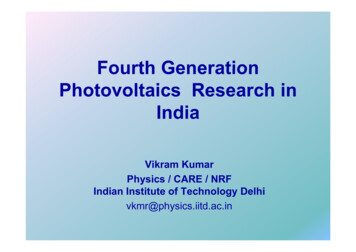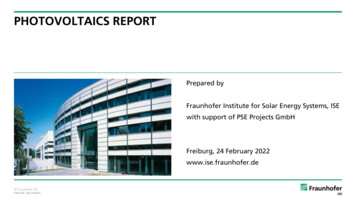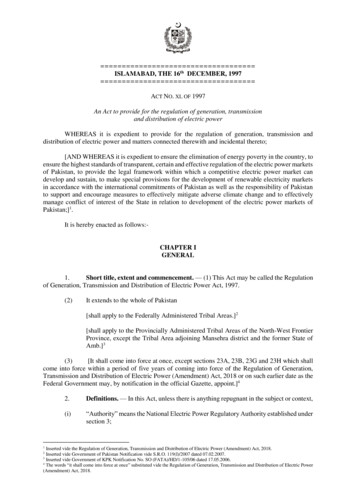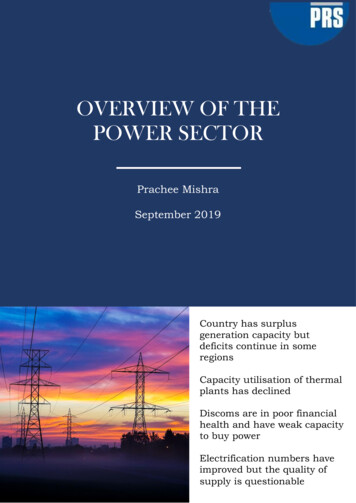
Transcription
Fourth GenerationPhotovoltaics Research inIndiaVikram KumarPhysicsy/ CARE / NRFIndian Institute of Technology Delhivkmr@physics.iitd.ac.in
Photovoltaic DevicesDirect conversion of Sunlight into ElectricityConventional Silicon Solar cellsLimitations¾ Single and Polycrystalline Silicon¾ Highg Cost¾ Commercial Efficiency 16 %¾ Large Area Limitation¾ Efficiency at Laboratory scale 26%¾ Less FlexibilityThin Film Solar Cells¾ a Si , CdTe, CIGS and thin film crystalline Si¾ Commercial Efficiency 10 %¾ Efficiency at Laboratory scale 16 %Search for costeffectivealternativesOrganic Solar cellsNanocomposite/organic Solar
Why Organic Photovoltaics Solar energy demand has grown at 9 Production facilities are 10xcheaper than those for anya rate of 30% p.a. over the lasttraditional PV technologygy15 years9 Low unit costs enable use The global market for PVeven for shorter lifecyclesinstallations estimated at 18 b Currently the market is heavily 9 New form factors(semitransparent foil) allowdependent on governmentcompletely new applicationssubsidiesi iLifetimeEfficiencyCostsflexibility, weight, large area, low cost, tailored properties3
Current in Organic SemiconductorsOS is sandwiched betweencontacts with different workfunctions (eg. Al and ITO) givingrise to an electric fieldNeed to understand Charge injection Carrier Generation Transport RecombinationCurrentholeselectrons PPV forms ohmic contact with ITO, Au for holes. Ca, Al for electrons Electron onlyy and hole onlyydevices depending on theinjecting contact4
Organic solar cellsSmall moleculesOrganic/inorganic hybrid(vacuum evaporation)(spin process)Conjugated Polymers(spin process)
Excitonic PV Researchin India National Physical LaboratoryLaboratory, New Delhi ( ( 2.0%)2 0%) Jawaharlal Nehru Center for Advanced ScientificResearch, Bangalore ( 2.0%)( 2.0%) Indian Institute of Technology, Kanpur ( 1.8%) Tata Institute of Fundamental Research, Bombay Indian Institute of Technology, Delhi University of DelhiDelhi, South CampusCampus, Delhi Jawaharlal Nehru University, Delhi
Donor and Acceptor Materials Hole Acceptors– PPV,, MEH-PPV,, MDMO-PPV,, P3HT,, etc Electron Acceptors (high electron affinities)– CN-PPV,CN PPV C60,C60 C60 polymers,polymers 66,6-phenyl6 phenyl C61C61butyric acid methyl ester (PCBM), perylenes P3HT/PCBM isi mostt widelyid l useddOOnOOn
OPV – Working principle(Exciton)
Earlyy work with bilayery cellsInitially two layer solar cells were madeC. W. Tang , APL 48,183, 1986 CuPC/Perylrene dye cell withη 1% Interface between the organiclayersaye s iss ccrucialuc a ratherat e thant a thet eelectrode/organic contactN. S. Sariciftci et al., APL 62, 585 (1993) PPV/C60 heterojunctionRectification ratio in the dark 104Short circuit current linear up to 1W/cm2Efficiency under monochromatic light »10-1 %9
Distributed Heterojunctionj Mix electron acceptor and hole acceptor materials togethergthe bulk Distribute active interfaces throughout All excitons are within a diffusion range of an interface Exciton dissociation at the PPV/C60 interface Electrons transferred to one component, holes to the other Charges travel to respective electrodesCurreent (A/cm2)10-310-510-710-9dark10-1 -22090202illuminated-110Bias (V)12G. Yu and A. J. Heeger: J. Appl. Phys. 78, 4510-5 (1995)10
CuPC(organic)Narrow BandEnergy (eV)Energy (eV)Organic absorbs in a narrow bands Can use multiple layers((tandem solar cells))Abssorptionn Coefficcient (cmm-1)Abbsorptionn Coefficcient (cmm-1)Absorption BandGaAs(Inorganic)Narrow BandEnergy (eV)Inorganics absorb in wider bandsAbsorbs all photons in solar spectrumwith energy above bandgap energyThe absorption coefficient values are usually higher in organic solar
Exciton FormationhνLUMO levelElectronEltexcitedit dto higher energy levelHOMO level Absorbed photon creates an exciton Excitons do NOT always form free electrons andholeso es– This is especially true in organic semiconductors– Here, strong field are needed to dissociate excitons
SunlightPhotovoltaic Process In OrganicgSolarCellsCouplingof sunlightintosolar cellAbsorptionofincidentphotonsLightLihtPh iciency of this step is 100%for inorganic solar cellsSeparationof chargesby built-inE field&Collectionof chargesatelectrodesChargesChargesRecombine Recombine''
Built in FieldBuilt-inφbiEfEbuilt-inb ilt iOOrganicMateriali M t i lφbip-typeEbuilt-inn-typeInorganic semiconductordNo charge of its ownBuilt-in potential depends on electrode work function difference
In Typical OSCOSC is typically different from inorganic solar cells in the following ways: Absorption in a narrower spectral band Usuallyy highg absorptionpcoefficient Exciton bindingg energygy higherg Poor chargeg mobilityy Built-in potential dependent on electrodes
bi-layer and bulk-heterojunction(blend) organic solar cells09020216
Optical Absorption in PPV-PCBMBlendsPCBM composition isdecreasing from 1-6PCBMTotal absorption is decreasingwith the increase in the PCBMconcentrationStill best performance at 80%.PPVJain et al, Syn Met, 148, 245 (2005)
Bulk heterojunction polymer solar CellsITO/PEDOT:PSS/P3HT:PCBM (1:1)/A0.0102Current density (A/cm )Dark0.005Ill i t 0.51.0Voltage 133.21.99Device active area 11.2 mm218
Small molecular PV 0.20D kDark0.10Currrent density (A/cm )Absorbaance (a.u.)0.35ZnPc0.150.100.05Illuminated0.080 060.060.040 020.020.00300400500600700800-0.020.02Wavelength (nm)-2-1012Voltage (V)S 09Device active area 9.1 mm219
Dual donors for broad spectralpcoveragegITO/CuPc(20-x nm)/Sub-Pc(x nm)/C60(40 nm)/BPhen(8 nm)/Alx(nm)Voc (V)Jsc(mA/cm2)FF (%)PCE (η) (%)00.422.6845.30.6410 420.423 303.3038 838.80 670.6720.425.1647.81.2930.432.6140.00.5650 500.502 122.1212 612.60 170.17200.603.1325.20.59Device exhibited maximum efficiency 1.3 % for x 2 nmKumar et al. J. Phys. D: Appl. Phys. 42, 15103 (2009)20
Bulk heterojunction polymer solar CellsITO/PEDOT:PSS/P3HT:PCBM (1:1)/Al0.0102Current density (A/cm )Dark0.005Ill i t 0.51.0Voltage .99Device active area 11.2 mm221
Effect of illumination and temperature on VocBilayer device ITO/CuPc/C60/BPhen/Al0.0100.005DarkOD 11.00OD 0.6OD 0.4OD 0.2OD 0.1OD 0.00.015295 K0.000-0.0050 010-0.010-1.0-0.50.00.51.0Voltage (V)Current deensity (A/cmm2)Curremt Dennsity (A/cm2)0.0150 0100.0100.005295 K274 K254 K233 K213 K0.000-0.005Initial illumination intensity - 80 mW/cm2Our modelOd l explainsl i ththeseobservations as well-0.0100 010-1.0-0.50.0Voltage (V)0.51.0
Four Pronged Approach Characterising the devices– Spectral response characterisation– Spectral ellipsometry Increasing efficiency of device– Physics and circuit model of organic solar cells– Choice of material– StructureSt t– blend,bl d bilbilayer, ttandemd – Process optimisationReliability and stability– Choice of material– Mechanism of degradation– EncapsulationptechniquesqNew & emerging technology issues– Novel methods of fabrication– System level issues
Suman BanerjeeSpectral Response AnalysisSuman Banerjee
P3HT:PCBM Solar CellCalcium-AluminiumCalciumAluminium CathodeP3HT:PCBM BlendGlassPEDOT:PSSITOPEDOT:PSS - 30 nm;P3HT:PCBM (1:1) - 90 nm;Ca - 6 nm; Al - 70 nm.Characterstics of a typical Organic (Polymer) Solar CellArun Tej Mallajosyula
Anirban BaguiEffect of Post Process AnnealP3HT: PCBM BlendH tHeterostructurettVinod Pagare 2007Aluminium CathodePolymer BlendPEDOT:PSSGlass ITO
Solvent Drying in EE-FieldFieldElectric Field Annealing during solvent drying step of active layerimproves device efficiencyAnirban BaguiIndian Patent being filed
Modifying Interface byAnnealingAs deposited CuPcSpecially Annealed CuPcSmoother with pillarsAnnealed CuPcSmootherAlActiveAreaC60Modification of interfacebetween CuPc and C60CuPcITOGlassAnukul Prasad ParhiIndian Patent being filed
Nanotubes in Polymer OSC241.20.9P3HT:PCBM:SWNT (0.75 %)P3HT:PCBM5.0JL (mmA cm-2)060.60.30.00.00.1Voltage (V)0.20.30.4(mA cm ) (%)18η 2.01 %η 2.99 %-0.6-1.2565Voc(mV)560214.5Jsc-2 FF4.0-0.3-0.9090.5570FFVocJscAM 1.5 GIntensity 6 mW cm-25553.5153.00.00.20.40.60.81.0SWNT wt% Incorporation of single walled nanotubes can improve solar cell performance Main role of nanotube is in charge transport within the solar cell NanotubeNanotube does not have much effect in exciton generation or dissociationAurn Tej Mallajosyula550
Degradation ModelsDegradation under Electrical & Optical Stress Statistically arrive at parameters that matter most Identify the physics of degradation Use learning to increase device lifetimeMunish Jassi 2006
Tandem small molecular solar cell withmixedi dhheterojunctionst jtiCell B Efficiency 5.7 0.3 % 100 mW/cm2J. Xue, Appl. Phys. Lett. 85, 5757 (2004).
Polymer Tandem bulk heterojunction solar cellTandem cell Efficiency 6. 5 %.Kim J Y et al. Science 317, 222 (2007).
Hybrid Organic-Inorganic Solar CellsPolymer: Inorganic Nanocomposites based Solar cells¾Cost Effective¾Efficient Electron Transport¾Strong Optical Absorption¾Effi i t exciton¾Efficientitdissociationdii ti¾Prepared by Inexpensive Wet Chemical Synthesis¾Possibility of Tailoring the Properties by varying thesize of the nanoparticles- quantum size effectNanoparticle–polymer cells generally have a photoactivelayery consistingg of interconnected semiconductinggnanoparticles in a solid semiconducting polymer phase i.e.interpenetrating phases of semiconducting polymers andnanoparticlesti l
General principlesppConjugated PolymersP3HT, MEH-PPVSemiconductingg Nanoparticles/QuantumpdotsCdSe, PbSe, CdTe, CdSexTe1-x, CdS, PbS, ZnO, TiO2Quantum dots have large surface energies highly unstable hightendency to agglomerate nonhomogeneous dispersion in polymermatrices hinders charge transport limits efficiency35
Tailoring AbsorptionCdSe ( Eg bulk 1.7 eV)CdTe ( Eg bulk 1.49 eV)PbSe ( Eg bulk 0.26 eV)PbS ( Egg bulk 0.37 eV))Energy-level positions of MEH-PPV, P3HT, and Semiconductor Nanocrystals (NCs)of different sizesUnlike PCBM and TiO2, CdSe nanoparticles absorb solarspectrumDevicesDicomposedd off polymerlandd NCNCs show:h good diode characteristics sizable photovoltaic response in spectral range fromthe ultraviolet to the infrared090202φλedge3 nm 650nm7 nm 72036nmX. Jiang et al., J. Mater. Res., Vol. 22, No. 8, 2007
Polymer:CdSe Nanocomposites Solar CellsW U.W.U Huynh et alal., Science 295 (2002) 24252425–777 nm diameter quantum dots7 nm diameter nanorodswith lengths 30 nmEnhanced EQE and power conversionefficiencies could be realized with the use ofhigh aspect ratio CdSe nanorods which provide adirect path for e transportThe use of nanorods and tetrapods of CdSewith P3HT and MEH-PPV, show powerconversion efficiencies of 1.8%The current-voltageTht ltcharacteristicsht i ti off 7 nm bby 60 nm nanoroddddevicei090202 rectification ratios of 105 in the dark and short circuit current ofexhibit0.019 mA/cm2 under illumination of 0.084 mW/cm2 at 515 nm37
Experiment Details for the Synthesisof CdSe NanoparticlesThe organometallic precursor route involves a coordinatingsolvent TOPO Trioctylphosphine Oxide which is hazardous,unstable, expensive and environmentally unfriendlyMuch cheaperp and safer non-TOP-based route for largegscale synthesis of CdSe QDs was proposed by Deng etal.(2005)Chemicals used:CdOTOPOTOPTDPASe- Cadmium Oxide- Trioctylphosphine Oxide- Trioctylphosphine- Tetradecylphosphonic Acid- Selenium PowderCapping agents used: Trioctylphosphine Oxide (TOPO) Oleic Acid ((OA))Cadmium to Selenium ratio:1:1; 2:1; 3:1090202Procedure:0.0514 g of CdO, 0.1116 g of TDPA and1.8884 g of TOPO were loaded into a 100mL flask. The mixture was heated to 300320 C underd AAr flflow, andd CdO wasdissolved in TDPA and TOPO. Solutionwas cooled to 270 C; selenium stocksolution 1M (0.0205 g of selenium powderdissolved in 1.2 ml of TOP) was injected.38After injection nanocrystals grew at 250
Colloidal Particles Engineer reactions to precipitate quantum dots fromsolutions or a host material (e.g. polymer) In some cases, need to “cap” the surface so the dotremains chemically stable (i.e. bond other molecules onthe surface)f) Can form “core-shell” structures Typically group II-VI materials (e.g. CdS, CdSe) Size variations ( “size dispersion”)CdSe core with ZnSshell QDsRed: bigger dots!Blue: smaller dots!
Synthesis approach:12 nm (CdO : Se 0.5:1)CdO TOPO/OA TDPATOP-Se/Ar gas7 nm (CdO : Se 1:1) 300o CSize regulating factor » Cdto Se precursor ratio9 nm (CdO : Se 3:1)TOPO/OA- capped CdSe5 nm (CdO : Se 2:1)optimized conditionPreparation of Polymer:CdSe NanocompositesToluene solvent:- CappedCd CdSCdSe particlesti lPyridine solvent:pp CdSe pparticles- UncappedFigure shows the Capped and Uncapped CdSe nanoparticles dispersed inPolymer matrix09020240
Synthesis of CdSe Quantum DotsConclusions9 We have successfully synthesized high quality CdSequantum dotsooNearly-monodispersedHighly Crystalline9 Cd:Se 2:1 is the optimized condition as for both the capping casessmallest particles were achievedCdS (OA) 2:1CdSe(OA)21 7 nmCdSe(TOPO) 2:1 5 nm9 CdSe(OA) 2:1 particles show better properties compared to CdSe(TOPO) 2:1- Steric stability- Photoluminescence- Photostability09020241
Effect of CdSe quantum dots on hole transporti poly(3-hexylthiophene)inl (3 h l hi h ) thinhi filfilmsAuP3HTPEDOT:PSSITOGlass substrateDevice 120 nmTEM image of CdSe quantumdots (size 5 nm) dispersedin P3HT matrix in 1:1 weightratioAuP3HT:CdSePEDOT PSSPEDOT:PSSITOGlass substrateDevice 2The incorporation of CdSe quantum dots in P3HT results in enhancement inhole current and switches the transport from dual conduction mechanismmechanism, vizviz.,trap and mobility models to only trap model090202Kusum et al, Appl. Phys. Lett., 92, 263504 (2008)42
Demonstration of Solar Cell.P3HT: PCBMITO/ PEDOT:PSS/ P3HT:PCBM/ LiF/ AlJ (A/cm 2)P3HT: CdSe: PCBMITO/ PEDOT:PSS/ P3HT:CdSe:PCBM/ LiF/ Al-35.0x10-0.250.00.00Jsc 6.32 x 10-3 A/cm2 Jsc 8.88 x 10-3 A/cm20.250.50V (Volts)-3-5.0x10-2-1.0x10Voc 0.44 VVoc 0.48 VFF 0.435FF 0.36η 1.23 %η 1.91 %0.75P3HT: PCBMP3HT: CdSe: PCBM-2-1.5x109090202Reduction of barrier at active layer- acceptor interface43
Demonstration of Solar Cell.MEH-PPV:PCBMITO/ PEDOT:PSS/ MEHPPV:PCBM/ LiF/ AlMEHMEHPPV:CdSe:PCBMITO/ PEDOT:PSS/ MEHPPV:CdSe:PCBM/ LiF/ AlJ (AA/cm2 000.00-32.50x10-2.50x10MEH-PPV: PCBMMEH-PPV: CdSe: PCBM0.25A0.50V (Volts)Jsc 2.88 x 10-3 A/cm2 Jsc 7.37 x 10-3 A/cm2Voc 0.37 VVoc 0.41 VFF 0.46FF 0.40η 0.620 62 %η 1.471 47 %-5.00x10-3-7.50x10-3-1.00x10-2B CdSe QDs have a range of electron affinities reported from 3.5-4.5 eV helpin matching energy levels PCBM090202 provides additional conducting path allowing significant44enhancement of electron transport at even low doping levels
PolymerNanoparticles Voc JscEQE PCE(V) (mA/cm2)(%)OC1C10-PPVCdSe tetrapods0.759.10.522.8B. Sun et al., J Appl Phys97 (2005) 014914P3HTCdSe nanorods0.628.790.702.6B. Sun et al., Phys Chem Chem Phys 8(2006) 3557APFO-3CdSe nanorods0.957.230.442.4P. Wang et al., Nano Lett 6 (2006) 1789P3HTCdSe hbranch0 600.607 107.10222.2II. Gur et al.,al Nano Lett7 (2007) 409–14P3HTCdSe nanorods0.706.070.561.7W. U. Huynh et al., Science 295 (2002)2425–7MDMO-PPVZnO0.812.400.391.6WJE Beek et al., Adv Mater 16 (2004)1009–13MEH-PPVCdSe tetrapods0.692.860.461.13Zhou Y, Nanotechnology17 ((2006)) 4041–7MDMO-PPVZnO1.142.300.261.1WJE Beek et al., Adv Funct Mater 15(2005) 1703–7MEH-PPVCdSexTe1 x(CdSe0.78Te0.22)0.691.570.49Yi Zhou et. al., Nanotechnology 17(2006) 4041–40474041 4047MEH-PPVCdTenanocrystals0.770.190.42T. Shiga et al., Solar Energy Materials& Solar Cells 90 (2006) 1849–1858MEH-PPVPbS1 001.000 130.130 700.70AAR Watt etet. alal., J PhysD: Appl Phys 38 (2005) 2006–12P3HT090202PbSe0.351.080.14D Cui et al., Appl Phys Lett88 (2006) 1831110 210.21References45
The Potential ofOSCwww.konarka.comKonarka’s solar bags es/ Appotential cottageg industryy Production is distributedwww.scienceknowledge.org
Summaryy and Conclusions We have reviewed the status ofnovell solarl cellsll Nanoparticles are used inseveral different approaches toimprove the solar energyconversion efficiency New materials are the key toprogresspgto improvepabsorptionpfor longer wavelenghts There are several groupsworkingkion ththese aspectst iniIndia.
I thank numerous persons who havepcontributed to this presentation
First ggeneration PV
Second Gen PV
3rd Gen PV
4th Gen
CuPC(organic)Narrow BandEnergy (eV)Energy (eV)Organic absorbs in a narrow bands Can use multiple layers((tandem solar cells))Abssorptionn Coefficcient (cmm-1)Abbsorptionn Coefficcient (cmm-1)Absorption BandGaAs(Inorganic)Narrow BandEnergy (eV)Inorganics absorb in wider bandsAbsorbs all photons in solar spectrumwith energy above bandgap energyThe absorption coefficient values are usually higher in organic solar
Exciton FormationhνLUMO levelElectronEltexcitedit dto higher energy levelHOMO level Absorbed photon creates an exciton Excitons do NOT always form free electrons andholeso es– This is especially true in organic semiconductors– Here, strong field are needed to dissociate excitons
SunlightPhotovoltaic Process In OrganicgSolarCellsCouplingof sunlightintosolar cellAbsorptionofincidentphotonsLightLihtPh iciency of this step is 100%for inorganic solar cellsSeparationof chargesby built-inE field&Collectionof chargesatelectrodesChargesChargesRecombine Recombine''
Built in FieldBuilt-inφbiEfEbuilt-inb ilt iOOrganicMateriali M t i lφbip-typeEbuilt-inn-typeInorganic semiconductordNo charge of its ownBuilt-in potential depends on electrode work function difference
In Typical OSCOSC is typically different from inorganic solar cells in the following ways: Absorption in a narrower spectral band Usuallyy highg absorptionpcoefficient Exciton bindingg energygy higherg Poor chargeg mobilityy Built-in potential dependent on electrodes
At IIT Kanpur
Product Oriented Research220 m2 ISO 6 Cleanroomhttp://www.iitk.ac.in/scdt/
Members of SCDTFacultyScientists/ ResearchEngineers Dr. Deepak Gupta Dr. Y.N.Mohapatra Dr. Dr. B.Mazhari Dr.Dr Monica Katiyar Dr. Satyendra Kumar Dr. S.S.K.Iyer Dr. Ashish Garg Dr.Dr Sidhartha Panda Dr. J. Narain Dr. Vandana Singh Dr. Ashish GuptaVisiting ResearchEngineersSupport StaffMr. Dharmendra SwainMr. Arvind KumarMr. Ramnath YadavMr. Dinesh KumarMr. Ajay NaikMs. Mamata RaiMs. Shewta MauryaStudentsPh.D: 19M.Tech: 22B Tech/ MB.Tech/M.Sc.:Sc : 15 Dr. Unni Narain Dr. Asha Awasthi Mr. I. V. Kameshwar Rao Mr.Mr Ranbir Singh Mr. Boby C. Villari Mr. Pankaj Uttwani Dr. Ganesan Palaniswami
OLED Displays from IIT KanpurDisplayMetal LinesCOFDriverImages Captures on the displaymade at SCDTDisplay Module,Full Colour 96 (3) x 6464, 1”1,Passive Matrix, consisting of theOLED Display, COF and Driver.
SCDT Projects DisplaysLightingPrintable ElectronicsSolar CellsSensorsPushing the Envelope ofUnderstandingg of OrganicgDevicesOOLEDThe new age off Macro-electronicsPrintable, Flexible, Large, Cost Effective !CoreExpertise &Facilities
Technology StatusO-SensorsOSensorsWOLEDO-TFT (printable)O-Solar CellsOLED ithIndustrial Partner
On-going work at IIT Kanpur
From Materials to ApplicationsOrganic MoleculesDiscrete DevicesModuleApplications
Material SystemsWet ProcessingVacuum Thermal DepositionR Hexyl Imidazolin 5 oneImidazolin-5-oneModified Chromophor of GreenFluorescent Protein Prof. R. GurunathMg-chlorophyllModified Porphyrin moleculesProf. S.P. Rath
Four Pronged Approach Characterising the devices– Spectral response characterisation– Spectral ellipsometry Increasing efficiency of device– Physics and circuit model of organic solar cells– Choice of material– StructureSt t– blend,bl d bilbilayer, ttandemd – Process optimisationReliability and stability– Choice of material– Mechanism of degradation– EncapsulationptechniquesqNew & emerging technology issues– Novel methods of fabrication– System level issues
Suman BanerjeeSpectral Response AnalysisSuman Banerjee
P3HT:PCBM Solar CellCalcium-AluminiumCalciumAluminium CathodeP3HT:PCBM BlendGlassPEDOT:PSSITOPEDOT:PSS - 30 nm;P3HT:PCBM (1:1) - 90 nm;Ca - 6 nm; Al - 70 nm.Characterstics of a typical Organic (Polymer) Solar CellArun Tej Mallajosyula
Anirban BaguiEffect of Post Process AnnealP3HT: PCBM BlendH tHeterostructurettVinod Pagare 2007Aluminium CathodePolymer BlendPEDOT:PSSGlass ITO
Solvent Drying in EE-FieldFieldElectric Field Annealing during solvent drying step of active layerimproves device efficiencyAnirban BaguiIndian Patent being filed
Modifying Interface byAnnealingAs deposited CuPcSpecially Annealed CuPcSmoother with pillarsAnnealed CuPcSmootherAlActiveAreaC60Modification of interfacebetween CuPc and C60CuPcITOGlassAnukul Prasad ParhiIndian Patent being filed
Nanotubes in Polymer OSC241.20.9P3HT:PCBM:SWNT (0.75 %)P3HT:PCBM5.0JL (mmA cm-2)060.60.30.00.00.1Voltage (V)0.20.30.4(mA cm ) (%)18η 2.01 %η 2.99 %-0.6-1.2565Voc(mV)560214.5Jsc-2 FF4.0-0.3-0.9090.5570FFVocJscAM 1.5 GIntensity 6 mW cm-25553.5153.00.00.20.40.60.81.0SWNT wt% Incorporation of single walled nanotubes can improve solar cell performance Main role of nanotube is in charge transport within the solar cell NanotubeNanotube does not have much effect in exciton generation or dissociationAurn Tej Mallajosyula550
Degradation ModelsDegradation under Electrical & Optical Stress Statistically arrive at parameters that matter most Identify the physics of degradation Use learning to increase device lifetimeMunish Jassi 2006
PlasmonicsBulk MetalNanoscale metalDecreasingthe size Unoccupied states5 nmoccupiedpstatesClose lyingy gbandsSeparation betweenthe valence andconduction bandsUnbound electrons havemotion that is not confinedElectron motion becomesconfined, and quantization sets inParticle size mean free pathpof electrons
Unusual Properties on the nm Scale are realizedin centuries backIf you take gold and makeparticles about 10 nm indiameter, it looks wine-redor blue-grayblue gray, depending onhow close the particles aretogetherruby-red stainedglass from goldnanoparticles
Surface Plasmon Absorption of AuNanoparticles 520 nmA b s o r p t io n0.30.20.1Au colloids Size 7-8 nm0300400500600700800Wavelength (nm)Optical response of a nanoparticle depends on its size, shape,collectivell ti behaviourb h iandd llocall didielectricl t i environmentitSurface plasmon absorption is due to coherent motion of conduction band electronsafter incident EM radiation Au NPs- - --- - --
Metal Nanoparticles -Localized surface plasmonspCollective motion of electrons is called “plasmaoscillation” Plasma frequency is in UV region – Au,AuAg, Al7-8 nmBulk GoldRough surface Grating structureNanoparticles - - -- - -Metal nanoparticles Conduction electrons acts like oscillatorsystem
Plasmonics for photovoltaics¾ Conventional Si solar cellscells, light trapping istypically achieved using a pyramidal surfacetexture that causes scattering of light into thesolar cell over a large angular rangerange, therebyincreasing the effective path length in the cell.¾ Such large-scale geometries are not suitable for thin-film cells, forgeometrical reasons (as the surface roughness would exceed the filmthickness) and because the greater surface area increases minority carrierrecombination in the surface and junction regions.¾ A method for achieving light trapping in thinthin-filmfilm solar cells is the useof metallic nanostructures that support surface plasmons:o excitations of the conduction electrons at the interface between ametal and a dielectricdielectric.o By proper engineering of these metallodielectric structures, lightcan be concentrated and ‘folded’ into a thin semiconductor layer,thereby increasing the absorptionabsorption.o Both localized surface plasmons excited in metal nanoparticlesand surface plasmon polaritons (SPPs) propagating at themetal/semiconductor interface are of interest.
Plasmonic light-trapping geometries for thin-filmsolar cells(a) Light trapping by scattering from metal nanoparticlesat the surface of the solar cell. Light is preferentiallyscattered and trapped into the semiconductor thin filmby multiple and high-angle scatteringscattering, causing anincrease in the effective optical path length in the cell.(b) Light trapping by the excitation of localized surfaceplasmons in metal nanoparticles embedded in thesemiconductor. The excited particles’ near-fieldcauses the creation of electron–hole pairs in thesemiconductor.(c) Light trapping by the excitation of surfaceplasmon polaritons at the metal/semiconductorinterface. A corrugated metal back surface couplesg to surface pplasmon ppolariton or pphotonic modeslightthat propagate in the plane of the semiconductorlayer.Nature materials VOL 9, 2010,205
Surface plasmon enhanced Sisolar cella. Enhancement from a doublesidedid d polishedli h d Si waferfcharacterized optically using aspectrophotometer with particlesizes formed from differentmass thickness of silver byythermal evaporation followed byannealing.b Totalb.T t l andd diffusediffreflectancefl tplots from a double-sidedpolished Si wafer with 30 nm topoxidePillai et al JAP,101, 093105 2007
Phosphorsp Photon accounting of a Si solar cells shows about29% photons with energy 11.11 eV are not effective incontributing to the output energy due to thethermalization of the excited electrons/holes to therespective band edges. The photons with energy below the band gap are notabsorbed in the base region and are mostly lost.These two optical lossescombine to result in 50% ofthe photon energy notcontributing to thephotovoltaic conversionp
Downconversion The second loss mechanism is imperfect collection dueto recombination close to or at the surface.surface Since high energy photons are absorbed in this regiontheyy are more likelyy to be affected and the result is areduced spectral response at shorter wavelengths. This loss can be reduced by using phosphors thatabsorb near UV to 500 nm,nm whereby emitting energy inthe higher spectral response region (500 -1000 nm) ofthe Solar cell.
Upconversion ThThe thirdthi d losslmechanismh iisi transmission,ti iwhichhi hoccurs because photons with energy less than theband ggapp of silicon are not absorbed. Transmission losses can be reduced by employingup-conversion (UC) processes, whereby two or morellowenergy photonsh tcombinebi tot createt one higherhi henergy photon. Spectrum modification is the most promisingsolution for enhancing the cell efficiency butunfortunately, no breakthrough has been reportedyett ini thisthi area. ThisThi makesk theth issueimore targetttoriented and challenging to pursue research forsuitable phosphor/nanophosphor coatings forimprovements in the efficiency of solar cell.
NPLINDIALOSSESSOLUTIONThermalization.Wavelengthg 2Egg of SiDown Conversion/ PhotoluminescencePhosphorsTransmission.Wavelength Eg of SiUp Conversion Phosphors
Up-Conversion (UC) Phosphor: Absorbs IR and emits in VIS-NIRDown Conversion (DC) Phosphor: Absorbs UV-VIS and emits in VIS-NIRThe Phosphor Layer should be transparent to wavelengths other than its absorption.NPLINDIAIIT, Delhi
Solar Spectrum Modification Using Novel Nano and Bulk Phosphors for EnergyEfficient Solar CellsA ppromisingo s g coconceptcept foro eefficientc e t harvestinga est g oof sosolara eenergye gy ususingg sosolara cecellss issSpectrum Modification using phosphorsPhotographshh off YVOO4:Eu3 colloidal solution and redemission from spin coatedllayerunderd 254 nm.PL spectra of YVO4:Eu nanophosphor layerannealed at (a) 300 K, (b) 573 K, and (c) 773 K.TTablebl showingh i threehtimes increment in Isc at λ 300 nm.λ ceCell withYVO4:Eu3 47395005749.380019.217.0APL 93 (2008) 073103
Thin-film structures can reduce the costof solar power by using inexpensivesubstratesb t t andd a lowerlquantitytit anddquality of semiconductor material.However, the resulting short optical pathg and minorityy carrier diffusionlengthlength necessitates either a highabsorption coefficient or excellent lighttrapping.
Silicon NanowiresLight absorptionLongitudinal directionC i collectionCarrierll tiTTransversedirectiondi tiExcellent Light trapping structuresImproved material properties due to miniaturizationOffers new ggeometries for solar cells - not ppossible with bulk or thin filmsA SiNWs based solar cell (with radial p-n junctions):Theoretically(JAP 97, 114302(2005))mg-Si can be usedginstead of sg-SiSiNWs based solar cells are much less sensitive to the impurities ascompared with planar p-n junction solar cells half of the total energy required to fabricate a solarcell can be savedDirect impact on: Processing cost & Energy payback time
Fabrication of Nanowires¾ Gas-Phase Synthesis (Bottom up Approach)– Vapor-Liquid-Solid (VLS) Method(both by CVD and PVD methods)- PECVD, MBE etc.– Oxide Assisted Growth (OAG)¾ Etching Methods (Top down Approach) Metal catalyzed wet Chemical etching/Template-Based Synthesis Dry Etching such
- Physics and circuit model of organic solar cells - Choice of material - St tStructure - bl d bil t dblend, bilayer, tandem - Process optimisation Reliability and stability - Choice of material - Mechanism of degradation - Encappqsulation techniques New & emerging technology issues - Novel methods of fabrication










